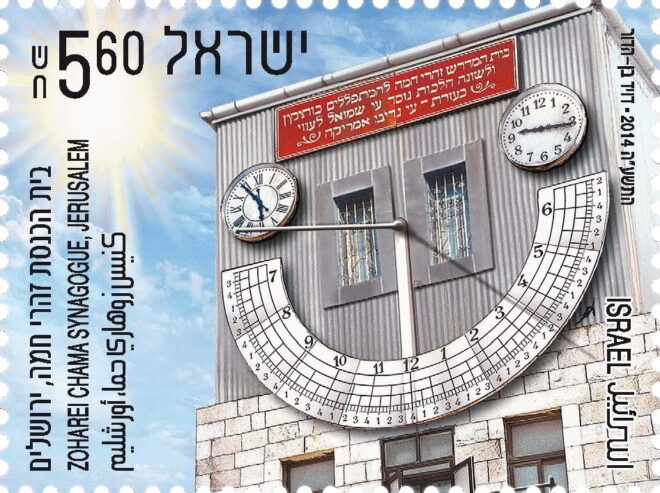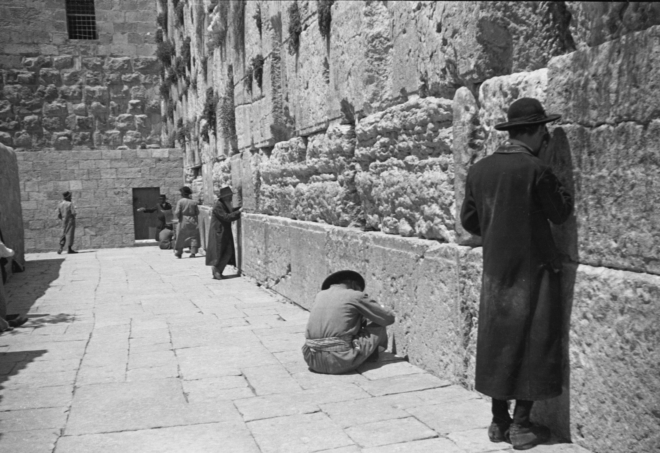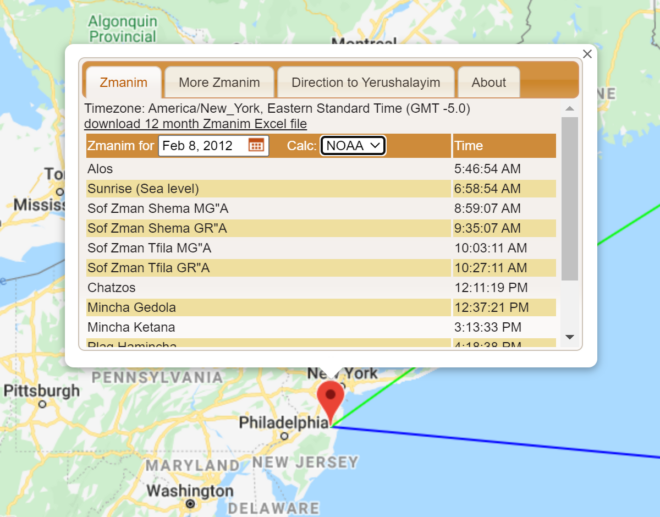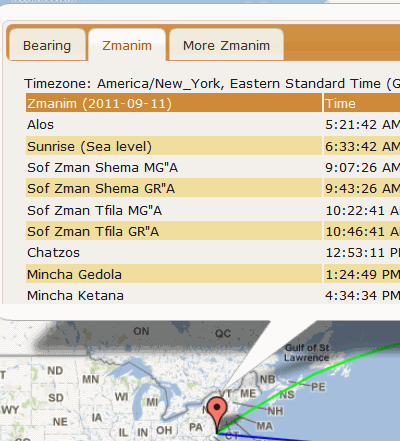
The KosherJava site now has a new vasikin calendar generator tool. This allows vasikin minyanim to generate customized vasikin charts. Offsets for various pre-sunrise davening points can be set. There are separate weekday, Shabbos, Yom Tov and Rosh Hashana / Yom Kippur offsets for each davening point. The format of the charts is Excel, but it is optimized for printing eye pleasing charts.
I would like to thank Howard Reichman who requested a vasikin calendar for the Los Angeles LINK Kollel vasikin minyan that ended up with the development of this zmanim tool. Howard graciously funded the next 7 months of hosting for KosherJava.com.
Tag: Davening
Tefila Rules Added to KosherJava Zmanim Library

Yahrzeits such as 7 Adar, (Moshe Rabbeinu’s yahrzeit) or holidays celebrated by specific communities such as Purim Mezhbizh (Medzhybizh) celebrated on 11 Teves or Purim Saragossa celebrated on the 17th of Shevat (the Wikipedia date seems to be in error), are not (and likely never will be) supported by this class.
Other tefila related rules such as the existing Mashiv Haruach etc. rules were moved over from the JewishCalendar class to this new class where they have a more natural fit. The methods that were migrated over, were deprecated in the JewishCalendar class and will be removed in v3.0.0.
Key Methods in the TefilaRules Class
The following are the key methods in the new TefilaRules class.
- Shemoneh Esreh Rules
- isMashivHaruachRecited(JewishCalendar)
- isMashivHaruachStartDate(JewishCalendar)
- isMashivHaruachEndDate(JewishCalendar)
- isMoridHatalRecited(JewishCalendar)
- isVeseinTalUmatarRecited(JewishCalendar)
- isVeseinTalUmatarStartingTonight(JewishCalendar)
- isVeseinTalUmatarStartDate(JewishCalendar)
- isVeseinBerachaRecited(JewishCalendar)
- Tachanun Rules
- Hallel Rules
- Possible Future Additions
- Lamnatzaiach
- Mizmor Lesoda
- Selichos
Yom Kippur Kattanadded to JewishCalendarHallel Shalem / Chatzi HalleladdedBeHaBadded to JewishCalendar- Vihi Noam on Motzai Shabbos
- …
Sample Code
TefilaRules tr = new TefilaRules(); JewishCalendar jCal = new JewishCalendar(); HebrewDateFormatter hdf = new HebrewDateFormatter(); hdf.setHebrewFormat(true); // Hebrew formatting jCal.setJewishDate(5783, JewishDate.TISHREI, 1); // Rosh Hashana System.out.println(hdf.format(jCal) + " - Is tachanun recited: " + tr.isTachanunRecitedShacharis(jCal)); jCal.setJewishDate(5729, JewishDate.SHEVAT, 21); System.out.println(hdf.format(jCal) + " - is mashiv haruch recited: " + tr.isMashivHaruachRecited(jCal)); jCal.setJewishDate(5783, JewishDate.ADAR, 17); System.out.println(hdf.format(jCal) + " - Is tachanun recited: " + tr.isTachanunRecitedShacharis(jCal)); tr.setTachanunRecitedWeekOfPurim(false); //default is true System.out.println(hdf.format(jCal) + " - Is tachanun recited: " + tr.isTachanunRecitedShacharis(jCal));
Output:
א׳ תשרי תשפ״ג - Is tachanun recited: false כ״א שבט תשכ״ט - is mashiv haruch recited: true י״ז אדר תשפ״ג - Is tachanun recited: true י״ז אדר תשפ״ג - Is tachanun recited: false
Zmanim Map 3.5 adds Date and Algorithm Selection
 The Zmanim Map was recently updated to version 3.5. This new release adds a number of new features (listed below), and some technical changes over the previous Zmanim Map 3.0 release. With this release, the main focus of the map has shifted to the zmanim tabs. The direction to Yerushalayim tab with davening directions using both the rhumb line and great circle route to Yerushalayim is still present, but is no longer the default tab.
The Zmanim Map was recently updated to version 3.5. This new release adds a number of new features (listed below), and some technical changes over the previous Zmanim Map 3.0 release. With this release, the main focus of the map has shifted to the zmanim tabs. The direction to Yerushalayim tab with davening directions using both the rhumb line and great circle route to Yerushalayim is still present, but is no longer the default tab.

- The date can now be selected by the user. In previous versions the date was always the current date on the user’s computer (though the map always supported passing the date on the URL using the undocumented date=1969-02-08 parameter). The current date is still the default, but the user can now change the date.
- The calculation algorithm is now selectable. The Zmanim API supports both the USNO and NOAA algorithms. The map has always used the USNO algorithm, and this remains the default, but users can now use the NOAA algorithm.
- The Zmanim tab is now the default tab. This reflects user feedback indicating that most people use the map for zmanim.
- An About tab now provides a mini user guide and general information about the map.
- The timezone look-up now uses the Google Time Zone API. Previously the map had been using the Geo Names web service. Since the elevation service also uses Google, the change to a single stable source will hopefully result in fewer outages.
- The currently selected tab persists across location changes, so if you were viewing zmanim for a location, and changed the location to see how the zmanim were affected, you will no longer have to change tabs after each move.
- Candle Lighting was added for Fridays. Erev Yom Tov will not show candle lighting at this point.
- Performance improvements, minor enhancements, bug fixes and refactoring
Bearing to Yerushalayim and Zmanim Map 3.0
 The Bearing to Yerushalayim and Zmanim Map was recently updated to version 3.0. This new release adds a number of new features to the Zmanim Map version 2.0 update released in March 2010. The main change was updating the Google Map API version from the deprecated v2 to v3. This change increases performance and adds much better support for mobile browsers. The upgrade also means that a Google Maps API key is no longer required. This makes it easy to drop it into any site without any configuration (contact me for details).
The Bearing to Yerushalayim and Zmanim Map was recently updated to version 3.0. This new release adds a number of new features to the Zmanim Map version 2.0 update released in March 2010. The main change was updating the Google Map API version from the deprecated v2 to v3. This change increases performance and adds much better support for mobile browsers. The upgrade also means that a Google Maps API key is no longer required. This makes it easy to drop it into any site without any configuration (contact me for details).  The technical notes on the original Technical Information about the Bearing to Yerushalayim Map post are still relevant, with very little having changed since the initial implementation.
The technical notes on the original Technical Information about the Bearing to Yerushalayim Map post are still relevant, with very little having changed since the initial implementation.
The following is a partial list of the new features:
- A number of additional zmanim in the More Zmanim tab, including tchilas and sof zman kiddush levana (if they occur on that day)
- A link to download a 12 month Zmanim calendar directly from the map (using the same spreadsheet used in the Zmanim Calendar Generator). Clicking on the link from the Zmanim tab will generate a calendar with most typically used zmanim, while clicking on the link in the More Zmanim tab will download the full set of zmanim. These are available as the Calendar Type option in the Zmanim Calendar Generator
- Increased use of jQuery and jQuery UI for formatting the zmanim tables to better match the site look & feel
- Refactoring to make the code more robust and slightly more maintainable
- Timezones for all of Israel now display the timezone of Asia/Jerusalem as opposed to the Asia/Gaza returned for parts of Israel by the GeoNames TimeZone web service
From a technical perspective there were a number of changes required due to updating the Google Maps API from v2 to v3. These include:
- v3 no longer supports tabbed info windows, so the tabs are now implemented using jQuery UI
- Renaming of a number of classes and functions such as GLatLng to LatLng
- A number of functions that were part of API v2 were removed in v3. One example is the removal of radians in the LatLng that had been available and was replaced by the google.maps.LatLng class. These missing functions required for the direction to Yerushalayim calculations are now supported in the Zmanim Map using prototypes
Davening Direction from Alaska
As mentioned briefly in the “Why Some Zmanim Never Occur” post, the Lubavitch Jewish Center of Anchorage, Alaska has an interesting davening (prayer) direction question. As explained in the “Bearing to Yerushalayim and Zmanim Map” (additional technical information is available in the “Technical Information about the Bearing to Yerushalayim Map” post), there are two opinions about the proper direction to face during Tfilah (prayers). The Levush and others are of the opinion that one should face the rhumb line direction to Yerushalayim, while the Emunas Chachamim and others are of the opinion that one should face the initial bearing of the great circle route. Both of these opinions would clearly use the shortest rhumb or great circle lines to Yerushalayim. As an example, a person standing on Har Hazaisim (Mount of Olives) a mile east of Har Habayis would not daven east using the logic that continuing east for approximately 21,175 miles[1] would reach Yerushalayim via global circumnavigation, when Har Habayis is just one mile to the west. The shul in Anchorage is located at a longitude of -149.861°. The antipode of Har Habayis is on the -144.764851 longitude line – 180° of longitude from Har Habayis. People on different sides of this line (this line is also the halachic dateline according to Rav Yechiel Michel Tucazinsky and others) will daven in opposite directions. The Anchorage shul with a longitude of -149.861° is 169.69 miles (273.1 km) west of the -144.764851° longitude line[2]. For this reason, the shul should daven not east, but west (255.78° from the north, or slightly south-west) if using the common rhumb line calculation, or north (355.67° from the north, or slightly west of north) if using the great circle calculation. Alaska is the only location in the world that has the -144.764851° longitude line cut across dry land, and is therefore the only non-ocean location to face this issue.
Notes:
1. Based on a rhumb line along the 31° 50′ circle of latitude as opposed to 24,901 miles at the equator) using a WGS84 Reference ellipsoid.
2. Rhumb line calculation as calculated by Movable Type using the same latitude for both points. The ellipsoidal shape of the earth is factored into this calculation. The short distance means that the 169.66 mi (272.98 km) great circle distance is very close to the rhumb line distance.